Page 399 of 527
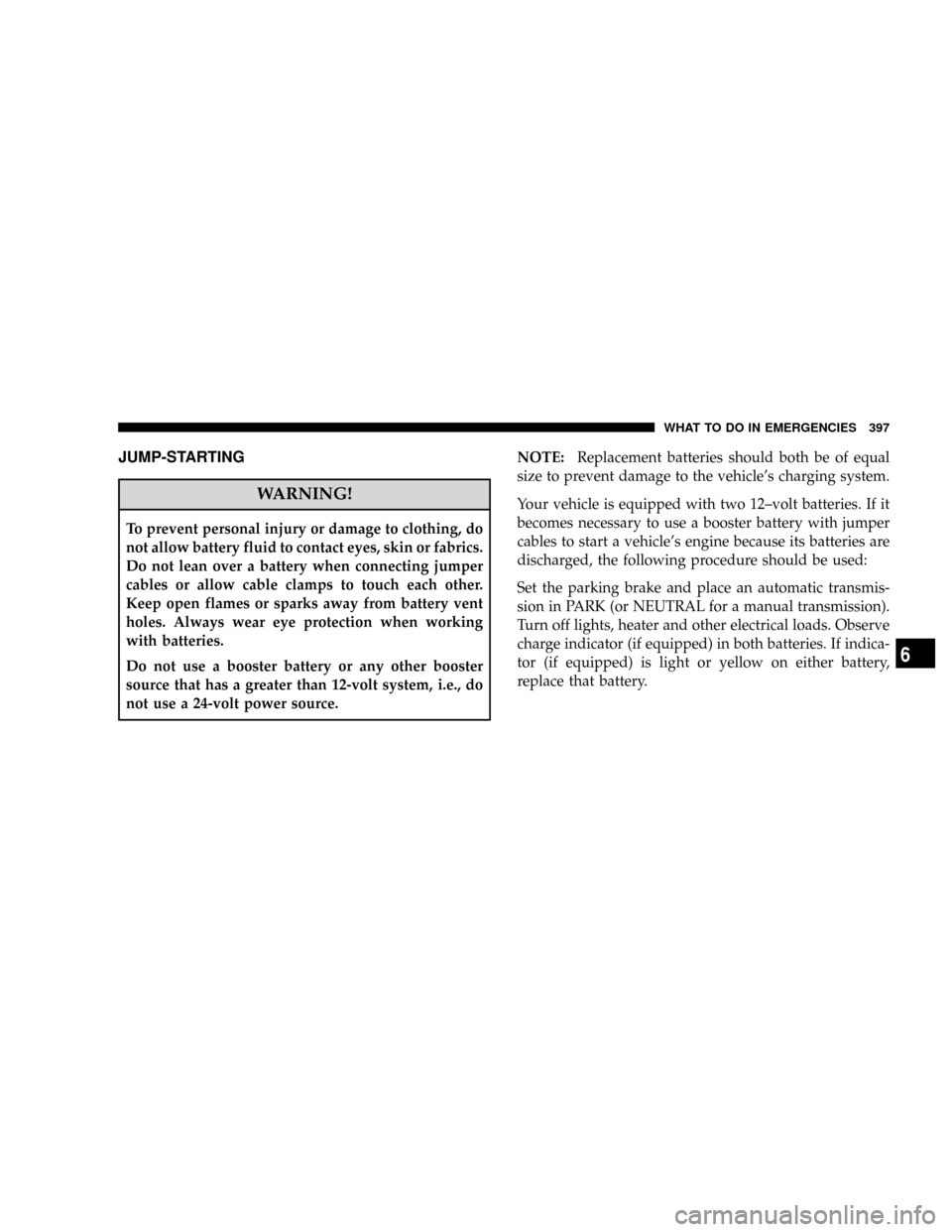
JUMP-STARTING
WARNING!
To prevent personal injury or damage to clothing, do
not allow battery fluid to contact eyes, skin or fabrics.
Do not lean over a battery when connecting jumper
cables or allow cable clamps to touch each other.
Keep open flames or sparks away from battery vent
holes. Always wear eye protection when working
with batteries.
Do not use a booster battery or any other booster
source that has a greater than 12-volt system, i.e., do
not use a 24-volt power source.NOTE:Replacement batteries should both be of equal
size to prevent damage to the vehicle's charging system.
Your vehicle is equipped with two 12±volt batteries. If it
becomes necessary to use a booster battery with jumper
cables to start a vehicle's engine because its batteries are
discharged, the following procedure should be used:
Set the parking brake and place an automatic transmis-
sion in PARK (or NEUTRAL for a manual transmission).
Turn off lights, heater and other electrical loads. Observe
charge indicator (if equipped) in both batteries. If indica-
tor (if equipped) is light or yellow on either battery,
replace that battery.
WHAT TO DO IN EMERGENCIES 397
6
Page 408 of 527
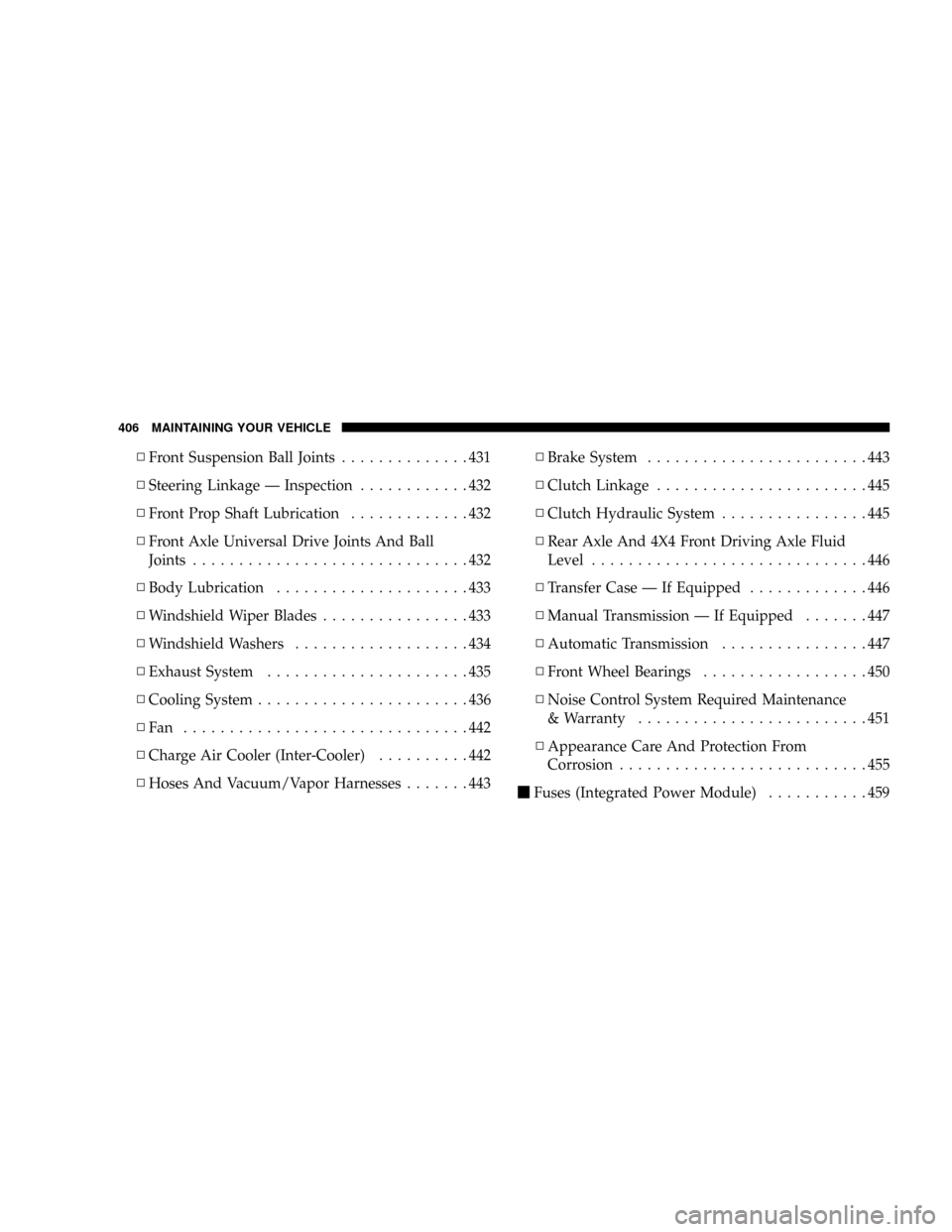
NFront Suspension Ball Joints..............431
NSteering Linkage Ð Inspection............432
NFront Prop Shaft Lubrication.............432
NFront Axle Universal Drive Joints And Ball
Joints..............................432
NBody Lubrication.....................433
NWindshield Wiper Blades................433
NWindshield Washers...................434
NExhaust System......................435
NCooling System.......................436
NFan ...............................442
NCharge Air Cooler (Inter-Cooler)..........442
NHoses And Vacuum/Vapor Harnesses.......443NBrake System........................443
NClutch Linkage.......................445
NClutch Hydraulic System................445
NRear Axle And 4X4 Front Driving Axle Fluid
Level..............................446
NTransfer Case Ð If Equipped.............446
NManual Transmission Ð If Equipped.......447
NAutomatic Transmission................447
NFront Wheel Bearings..................450
NNoise Control System Required Maintenance
& Warranty.........................451
NAppearance Care And Protection From
Corrosion...........................455
mFuses (Integrated Power Module)...........459
406 MAINTAINING YOUR VEHICLE
Page 449 of 527
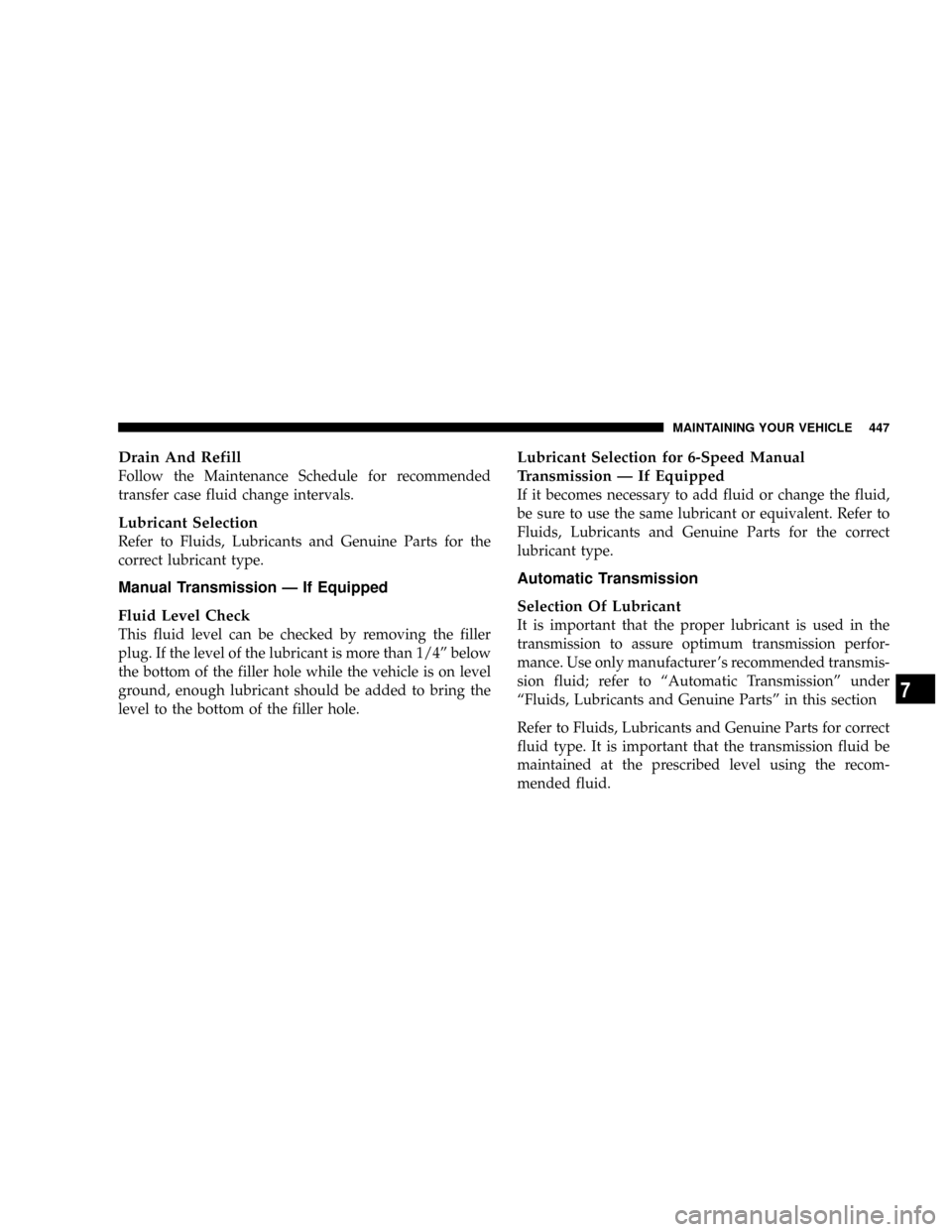
Drain And Refill
Follow the Maintenance Schedule for recommended
transfer case fluid change intervals.
Lubricant Selection
Refer to Fluids, Lubricants and Genuine Parts for the
correct lubricant type.
Manual Transmission Ð If Equipped
Fluid Level Check
This fluid level can be checked by removing the filler
plug. If the level of the lubricant is more than 1/4º below
the bottom of the filler hole while the vehicle is on level
ground, enough lubricant should be added to bring the
level to the bottom of the filler hole.
Lubricant Selection for 6-Speed Manual
Transmission Ð If Equipped
If it becomes necessary to add fluid or change the fluid,
be sure to use the same lubricant or equivalent. Refer to
Fluids, Lubricants and Genuine Parts for the correct
lubricant type.
Automatic Transmission
Selection Of Lubricant
It is important that the proper lubricant is used in the
transmission to assure optimum transmission perfor-
mance. Use only manufacturer 's recommended transmis-
sion fluid; refer to ªAutomatic Transmissionº under
ªFluids, Lubricants and Genuine Partsº in this section
Refer to Fluids, Lubricants and Genuine Parts for correct
fluid type. It is important that the transmission fluid be
maintained at the prescribed level using the recom-
mended fluid.
MAINTAINING YOUR VEHICLE 447
7
Page 450 of 527
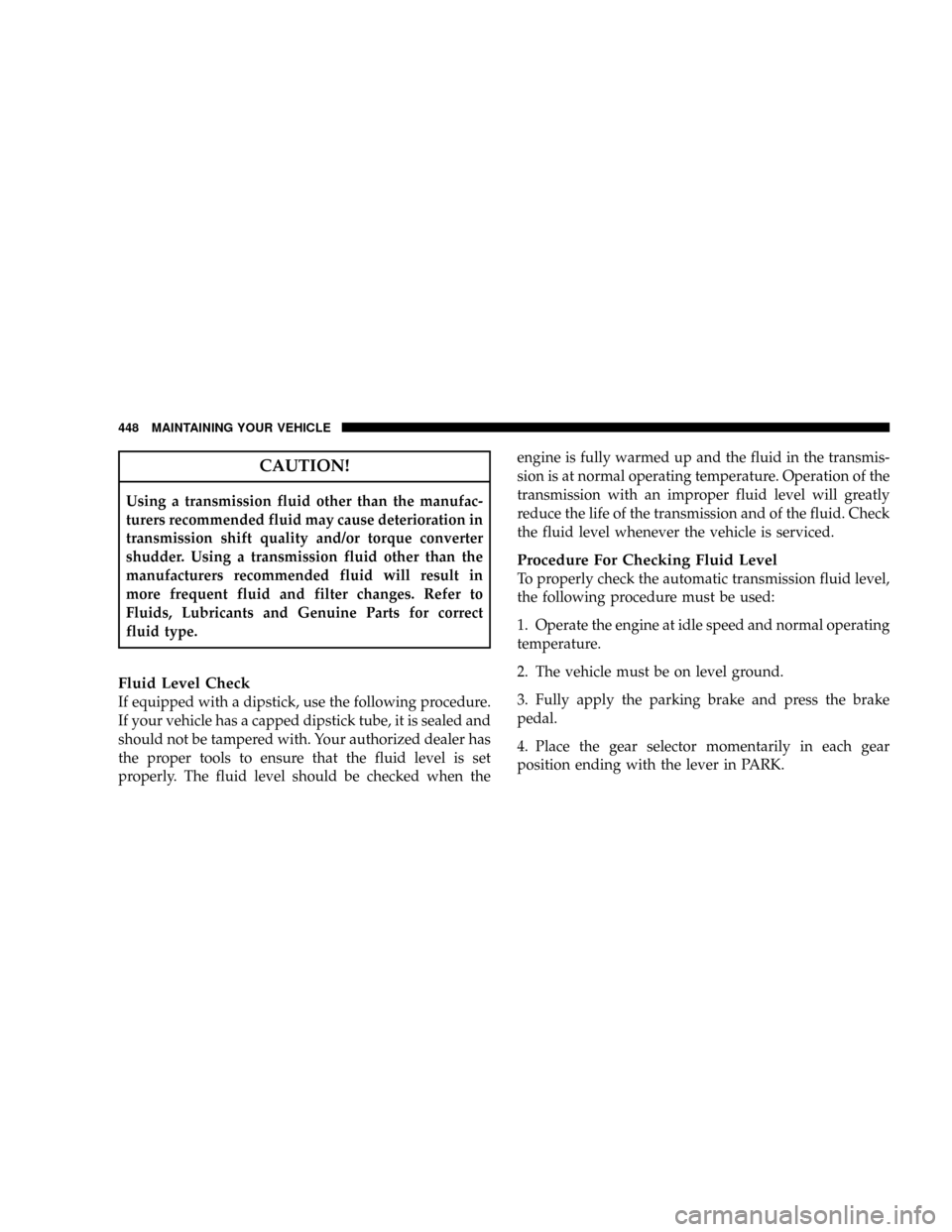
CAUTION!
Using a transmission fluid other than the manufac-
turers recommended fluid may cause deterioration in
transmission shift quality and/or torque converter
shudder. Using a transmission fluid other than the
manufacturers recommended fluid will result in
more frequent fluid and filter changes. Refer to
Fluids, Lubricants and Genuine Parts for correct
fluid type.
Fluid Level Check
If equipped with a dipstick, use the following procedure.
If your vehicle has a capped dipstick tube, it is sealed and
should not be tampered with. Your authorized dealer has
the proper tools to ensure that the fluid level is set
properly. The fluid level should be checked when theengine is fully warmed up and the fluid in the transmis-
sion is at normal operating temperature. Operation of the
transmission with an improper fluid level will greatly
reduce the life of the transmission and of the fluid. Check
the fluid level whenever the vehicle is serviced.
Procedure For Checking Fluid Level
To properly check the automatic transmission fluid level,
the following procedure must be used:
1. Operate the engine at idle speed and normal operating
temperature.
2. The vehicle must be on level ground.
3. Fully apply the parking brake and press the brake
pedal.
4. Place the gear selector momentarily in each gear
position ending with the lever in PARK.
448 MAINTAINING YOUR VEHICLE
Page 452 of 527

Automatic Transmission Fluid and Filter Change
To obtain best performance and long life for automatic
transmissions, the manufacturer recommends that they
be given regular maintenance service by an authorized
dealer or Service Center. It is important that the trans-
mission fluid is maintained at the correct level, and that
it is drained and refilled as specified.
Use only manufacturer 's recommended transmission
fluid; for correct fluid type, refer to ªAutomatic Trans-
missionº under ªFluids, Lubricants and Genuine Partsº
in this section. It is important that the transmission fluid
be maintained at the prescribed level using the recom-
mended fluid..
The fluid and filter(s) should be changed as specified in
the Maintenance Schedule (Section 8).
NOTE:If the transmission is disassembled for any
reason, the fluid and filter should be changed.
Special Additives
Automatic Transmission Fluid (ATF) is an engineered
product and its performance may be impaired by supple-
mental additives. Therefore, do not add any fluid addi-
tives to the transmission. The only exception to this
policy is the use of special dyes to aid in detecting fluid
leaks. In addition, avoid using transmission sealers as
they may adversely affect seals.
Front Wheel Bearings
Front wheel bearings for your vehicle are sealed-for-life.
They do not require greasing or seal replacement. In
some instances, these bearings will ªpurgeº excess grease
and the bearing housing will look slightly wet. This is
normal.
²Periodic inspection for excess play is recommended.
²If a bearing assembly is accidentally separated when
servicing the brake rotors, it should be replaced.
450 MAINTAINING YOUR VEHICLE
Page 484 of 527
Chassis
Component Fluids, Lubricants and Genuine Parts.
Automatic Transmission MopartATF+4, Automatic Transmission Fluid.
Transfer Case MopartATF+4, Automatic Transmission Fluid.
Manual Transmission Fluid G-56 MopartATF+4, Automatic Transmission Fluid.
Clutch Linkage Multipurpose Grease, NLGI Grade 2 E.P. or equivalent.
Front and Rear Axle Fluid 2500/3500
ModelsGL-5 SAE 75W-90 Synthetic or equivalent.Limited slip additive is not re-
quired.
Brake Master Cylinder MopartDOT 3 and SAE J1703 should be used or equivalent. If DOT 3
brake fluid is not available, then DOT 4 is acceptable. Use only recom-
mended brake fluids.
Power Steering Reservoir MopartATF+4, Automatic Transmission Fluid.
482 MAINTAINING YOUR VEHICLE
Page 487 of 527
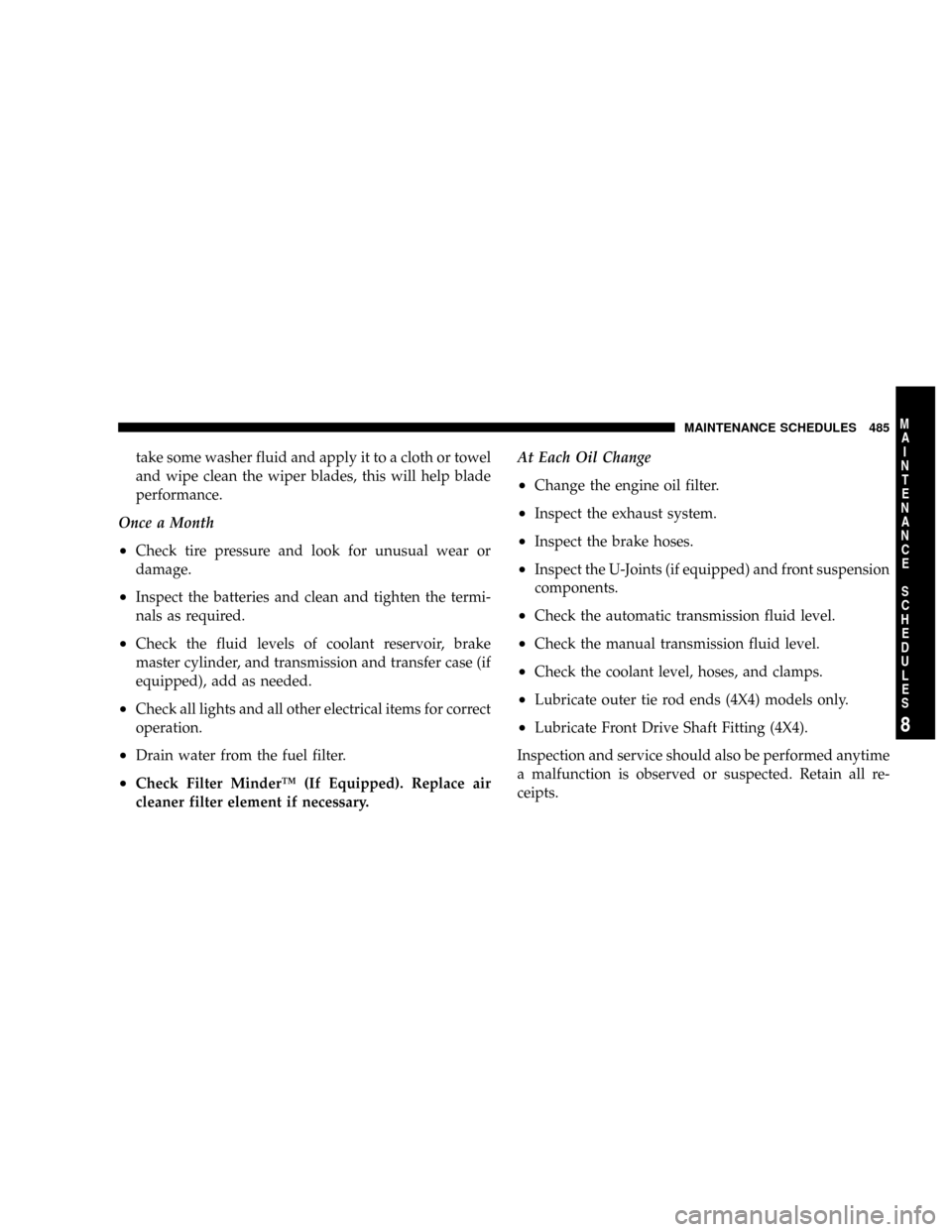
take some washer fluid and apply it to a cloth or towel
and wipe clean the wiper blades, this will help blade
performance.
Once a Month
²Check tire pressure and look for unusual wear or
damage.
²Inspect the batteries and clean and tighten the termi-
nals as required.
²Check the fluid levels of coolant reservoir, brake
master cylinder, and transmission and transfer case (if
equipped), add as needed.
²Check all lights and all other electrical items for correct
operation.
²Drain water from the fuel filter.
²Check Filter MinderŸ (If Equipped). Replace air
cleaner filter element if necessary.At Each Oil Change
²Change the engine oil filter.
²Inspect the exhaust system.
²Inspect the brake hoses.
²Inspect the U-Joints (if equipped) and front suspension
components.
²Check the automatic transmission fluid level.
²Check the manual transmission fluid level.
²Check the coolant level, hoses, and clamps.
²Lubricate outer tie rod ends (4X4) models only.
²Lubricate Front Drive Shaft Fitting (4X4).
Inspection and service should also be performed anytime
a malfunction is observed or suspected. Retain all re-
ceipts.
MAINTENANCE SCHEDULES 485
8
M
A
I
N
T
E
N
A
N
C
E
S
C
H
E
D
U
L
E
S
Page 490 of 527
(Miles) (45,000) (52,500) (60,000) (67,500) (75,000)
Kilometers 72 000 84 000 97 000 109 000 121 000
[Months] [36] [42] [48] [54] [60]
Change engine oil and engine oil filter. X X X X X
Lubricate Front Drive Shaft Fitting (4X4). X X X X X
Rotate tires. X X X X X
Lubricate outer tie rod ends. X X X X X
Change the transfer case fluid (4X4). X
Change front and rear axle fluid (4X4). X X X
Change the automatic transmission fluid & filter if
using your vehicle for any of the following: police,
taxi, fleet or frequent trailer towing.X
Change manual transmission fluid. X
Flush and replace engine coolant at 60 months, if
not replaced at 100,000 miles (160 000 km).***X
Inspect drive belt, replace as necessary. X X
Replace fuel filter element. X X X
488 MAINTENANCE SCHEDULES
8
M
A
I
N
T
E
N
A
N
C
E
S
C
H
E
D
U
L
E
S